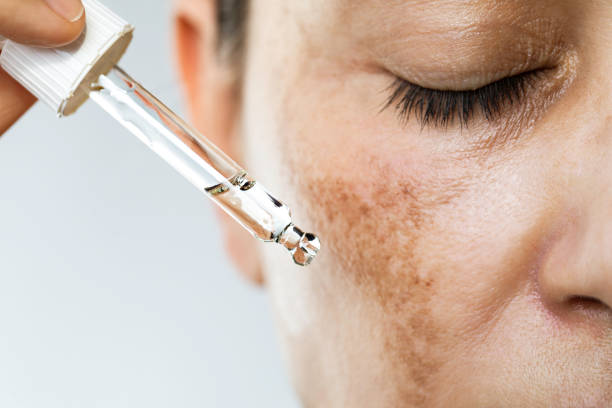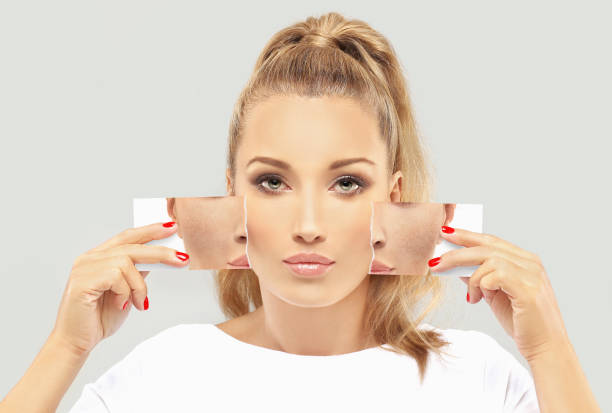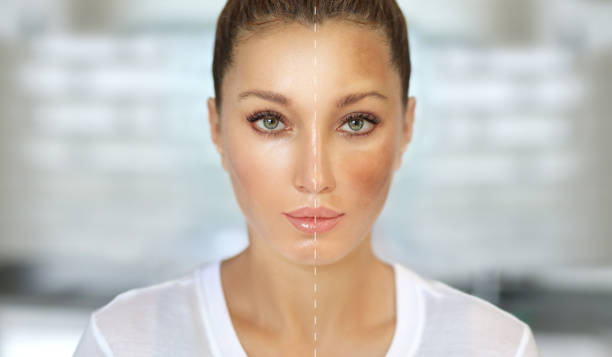I. Introduction
Hyperpigmentation is a common skin condition that affects individuals of all ages, often leading to concerns about appearance and self-confidence. Understanding the causes and effective treatments for hyperpigmentation is crucial for those seeking healthier, radiant skin. In this comprehensive guide, we will explore the nuances of hyperpigmentation, from its origins to practical treatment options.
II. Understanding Hyperpigmentation
The skin’s pigment-producing process is intricate and vital. Melanocytes, the cells responsible for skin color, can be triggered by various factors, leading to hyperpigmentation. Different types, such as sun-induced and hormonal hyperpigmentation, exhibit unique characteristics. For instance, sun-induced hyperpigmentation commonly appears as dark spots after sun exposure. Moreover, specific triggers, like hormonal imbalances in conditions such as Addison’s disease, can intensify pigmentation issues.

III. Recognizing the Signs and Symptoms
Hyperpigmented skin is identifiable by darkened areas, often leading to concerns about appearance. It’s essential to distinguish hyperpigmentation from other skin conditions like eczema or psoriasis. Medical coding, such as the ICD-10 code for hyperpigmentation, aids healthcare professionals in accurate diagnosis and treatment planning.
IV. Factors Contributing to Hyperpigmentation
Sun exposure, often underestimated, is a significant catalyst for hyperpigmentation. When the skin is exposed to the sun’s harmful UV rays, melanocytes, the pigment-producing cells, go into overdrive, leading to an excess production of melanin. This surplus melanin manifests as dark spots and uneven skin tone, emphasizing the importance of sun protection.
Hormonal influences, whether occurring naturally within the body or due to medical conditions like Addison’s disease, can significantly worsen pigmentation issues. Hormonal imbalances can trigger melanin production, leading to hyperpigmentation in various parts of the body, including the face, neck, and hands. Individuals with conditions like Addison’s disease, where the adrenal glands do not produce enough hormones, often experience darkening of the skin, intensifying concerns about pigmentation.

Genetic predisposition is another vital factor contributing to hyperpigmentation. Some individuals are genetically prone to developing skin discoloration, making them more susceptible even with minimal sun exposure or hormonal fluctuations. Understanding one’s genetic background can help in proactive management and prevention efforts.
Inflammatory skin conditions, such as acne, can leave a lasting mark in the form of post-inflammatory hyperpigmentation. When acne lesions heal, they often leave behind dark spots or patches on the skin. This type of hyperpigmentation can be particularly distressing, affecting both adolescents and adults. Proper management of acne, including gentle skincare and timely intervention, can mitigate the risk of post-inflammatory hyperpigmentation, emphasizing the importance of holistic skincare practices.
V. Prevention and Protection
Prevention is not only the first line of defense against hyperpigmentation but also an ongoing commitment to skin health. Regular use of sunscreen with a high SPF rating is paramount in shielding the skin from harmful UV rays. Sunscreen acts as a barrier, preventing excessive melanin production and safeguarding the skin’s natural tone. Applying sunscreen on all exposed areas of the body, including the face, neck, arms, and legs, should be a daily ritual, regardless of the weather.
In addition to sunscreen, lifestyle modifications play a pivotal role in minimizing the risk of hyperpigmentation. Wearing protective clothing, such as wide-brimmed hats and long-sleeved shirts, provides extra coverage, reducing direct sun exposure to the skin. Seeking shade during peak sun hours, typically between 10 a.m. and 4 p.m., further limits UV radiation.

Maintaining a balanced diet rich in antioxidants is essential for nurturing overall skin health. Antioxidants, found in fruits and vegetables, combat free radicals, protecting the skin from damage. Including foods high in vitamin C, vitamin E, and beta-carotene enhances the skin’s natural defense mechanisms. Moreover, staying well-hydrated ensures proper skin hydration, preventing excessive dryness and promoting an even skin tone. Adequate hydration supports the skin’s elasticity, reducing the likelihood of developing areas of hyperpigmentation, especially around sensitive regions like the mouth.
VI. Treatment Options for Hyperpigmentation
Over-the-counter hyperpigmentation creams, formulated with potent ingredients like hydroquinone or kojic acid, are effective for mild cases of hyperpigmentation. These creams work by inhibiting melanin production, gradually lightening dark spots, and promoting an even skin tone.
Consistent application following the product guidelines, is crucial for optimal results. These creams are readily available and offer a convenient, non-invasive solution for those with minor pigmentation concerns.
For more severe cases of hyperpigmentation, prescription medications are often recommended. Retinoids, derived from vitamin A, are known for their skin-renewing properties. They enhance skin cell turnover, gradually fading dark spots and promoting a clearer complexion. Corticosteroids, available in topical forms, target inflammation, reducing hyperpigmentation caused by conditions like eczema or psoriasis. Prescription treatments are tailored to individual needs, necessitating consultation with a healthcare professional for proper assessment and guidance.

Dermatological procedures, performed under the supervision of trained professionals, are highly effective in targeting deeper pigment layers. Chemical peels involve:
- Applying a chemical solution to the skin.
- Exfoliating the top layers.
- Revealing fresh, even-toned skin underneath.
Laser therapy, on the other hand, employs focused laser beams to break down melanin deposits, leading to a more uniform complexion. These procedures require multiple sessions and personalized treatment plans, ensuring the best possible outcome for individuals with moderate to severe hyperpigmentation.
While natural remedies like aloe vera offer relief, it’s essential to manage expectations. Aloe vera, renowned for its soothing properties, can reduce inflammation and promote healing. However, the effects may vary from person to person, and it might not yield dramatic results for deep or persistent hyperpigmentation. Consulting a dermatologist for personalized guidance ensures a tailored approach, addressing specific concerns effectively.
VII. Skincare Routine for Hyperpigmented Skin
A tailored skincare routine is indispensable for managing hyperpigmentation and maintaining overall skin health. Gentle cleansing is the foundation of a successful skincare routine. Using a mild, fragrance-free cleanser helps remove impurities without stripping the skin of its natural oils. Harsh cleaners can exacerbate inflammation, worsening hyperpigmentation. Opting for products specifically formulated for sensitive skin ensures a gentle cleansing experience.
Incorporating targeted products, such as toners containing glycolic acid, aids in exfoliation, promoting a more even skin tone. Glycolic acid, an alpha hydroxy acid (AHA), helps slough off dead skin cells, revealing fresh, radiant skin underneath. Regular exfoliation prevents the buildup of dead skin cells, reducing the appearance of dark spots and promoting a smoother complexion. However, it’s essential to avoid over-exfoliation, as it can irritate the skin and worsen hyperpigmentation. Following the product instructions and incorporating exfoliation into the skincare routine once or twice a week is sufficient for most individuals.

Customizing the skincare routine based on the type and location of hyperpigmentation ensures optimal results. For example, individuals with hyperpigmentation around the mouth may benefit from using targeted treatments, such as serums or creams containing brightening agents like vitamin C or licorice extract. These ingredients specifically target melanin production, assisting in lightening dark spots and achieving a more uniform skin tone. Additionally, incorporating a hydrating moisturizer helps maintain skin elasticity, reducing the likelihood of developing dry, discolored patches.
In summary, understanding the factors contributing to hyperpigmentation is vital for proactive prevention and targeted treatment. By embracing a comprehensive approach, including sun protection, lifestyle modifications, suitable treatments, and a personalized skincare routine, individuals can effectively manage hyperpigmentation and nurture healthier, more radiant skin. Consulting a dermatologist ensures tailored guidance, addressing individual concerns and promoting skin confidence.
VIII. Lifestyle Changes and Diet
Stress management and adequate sleep positively impact skin health, reducing inflammation and promoting cellular repair. A nutrient-rich diet comprising fruits, vegetables, and omega-3 fatty acids supports skin regeneration. Hydration, both internal and external, maintains skin elasticity, preventing excessive dryness that can worsen hyperpigmentation.
IX. Coping with Emotional Impact
Hyperpigmentation can lead to emotional distress and lowered self-confidence. Acceptance of one’s natural skin tone is empowering. Seeking support from friends, family, or professionals can alleviate emotional challenges. Embracing a positive mindset fosters self-love, enhancing overall well-being.

X. Skin Confidence: Embracing Your Natural Glow
Embracing your natural beauty is a journey of self-discovery and acceptance. By understanding hyperpigmentation and adopting suitable skincare practices, you can enhance your skin’s health and radiance. Remember, everyone’s skin is unique; what matters most is feeling confident in your skin.
XI. FAQs About The Hyperpigmentation
Q1: Can hyperpigmentation be completely cured?
A1: While complete eradication may be challenging, various treatments can significantly reduce hyperpigmentation’s appearance, providing visible improvements.
Q2: Does sun exposure only cause hyperpigmentation?
A2: No, hyperpigmentation can also result from hormonal imbalances, genetics, and inflammatory skin conditions, among other factors.
Q3: Are natural remedies effective in treating hyperpigmentation?
A3: Natural remedies like aloe vera and lemon juice can help, but their results vary. Consulting a dermatologist for personalized guidance is recommended.
Q4: Can hyperpigmentation return after treatment?
A4: In some cases, yes. Proper sun protection and ongoing skincare are essential to minimize the risk of recurrence.
Q5: How long does it take to see results from hyperpigmentation treatments?
A5: Results vary based on the chosen treatment. Over-the-counter products may show improvement in a few weeks, while dermatological procedures might require several sessions for noticeable changes.
Q6: Can natural remedies eliminate hyperpigmentation?
A6: Natural remedies like aloe vera and lemon juice can help lighten hyperpigmented areas to some extent, but complete elimination is often challenging. Professional treatments and targeted skincare products are more effective for significant results.
Q7: Are there any side effects associated with prescription hyperpigmentation medications?
A7: Some prescription medications, such as retinoids and corticosteroids, can cause mild irritation, redness, or dryness during the initial stages of use. It’s essential to follow the dermatologist’s instructions and report any adverse reactions promptly.
Q8: How long does it take to recover after undergoing dermatological procedures like chemical peels or laser therapy?
A8: Recovery time varies based on the intensity of the procedure. Mild chemical peels may require a few days of redness and peeling, while deeper peels or laser therapy might necessitate a week or more for the skin to heal completely. Dermatologists provide specific post-procedure care instructions to facilitate a smooth recovery process.
Q9: Can hyperpigmentation be prevented in children and adolescents?
A9: Yes, hyperpigmentation can be prevented in children and adolescents by instilling sun protection habits from an early age. Encouraging the regular use of sunscreen, wearing protective clothing, and seeking shade during outdoor activities significantly reduce the risk of developing hyperpigmentation in later years.
Q10: Is hyperpigmentation reversible with lifestyle changes alone?
A10: In mild cases, adopting a healthy lifestyle, including sun protection, a balanced diet, and hydration, can prevent the worsening of hyperpigmentation. However, significant improvement or complete reversal often requires a combination of lifestyle changes, targeted skincare, and, in some cases, professional treatments recommended by a dermatologist.
In conclusion, understanding and addressing hyperpigmentation involves a multifaceted approach, from preventive measures to tailored skincare routines and professional treatments. By embracing your natural glow and seeking the proper support, you can confidently navigate your journey toward healthier, radiant skin. Remember, every step you take toward self-care contributes to your skin confidence and overall well-being.
Read also.. Unlocking Radiant Skin: The Secret to a Gorgeous Glow with Face Serums

